The pine tree state has another less familiar nickname that captures its essence: Vacationland.
Over 21,590 acres, you’ll enjoy a handful of activities in Maine, ranging from bird watching to mountaineering while visiting farmers’ markets and enjoying sea-to-table food in between.
Maine is popular among birders because of the variety of stunning birds it has, especially sea birds. In this article, we’ve made you a list of 26 must-see birds while you’re in Maine.
Red Birds in Maine
White-Winged Crossbill

- Scientific Name: Loxia Leucoptera
- Length: 6 – 6.7 in
- Weight: 0.8 – 0.9 oz
- Wingspan: 10.2 – 11 in
Males are red with orange hues and black wings with white bars. Females and young males are a dark yellow color with dark brown wings. Both have significantly crisscrossed bills, as the name suggests.
You’ll mostly find White-winged Crossbills in Boreal forests, where they live in flocks all year round. They’re not big fans of bird feeders, though.
You can spot them as flocks moving between spruce trees, where they open cones with their crisscrossed bills to eat the seeds inside. An individual can eat up to 3,000 seeds of conifer per day!
Northern Cardinal

- Scientific Name: Cardinalis Cardinalis
- Length: 8.3 – 9 in
- Weight: 1.5 – 1.7 oz
- Wingspan: 9.8 – 12.2 in
The Northern Cardinal is a year-long resident in Maine. Males are bright red with long tails and black masks, while females are pale brown and crested, with red tinges on the wings. Both have super thick bills to open seeds and eat what’s inside.
Northern Cardinals are frequent visitors to bird feeders. While they’re not there, they’ll probably be sitting in trees or low shrubs foraging.
Thanks to their bright colors and distinct appearance, Northern Cardinals are conspicuous and hard to miss.
Blue Birds in Maine
Black-Throated Blue Warbler
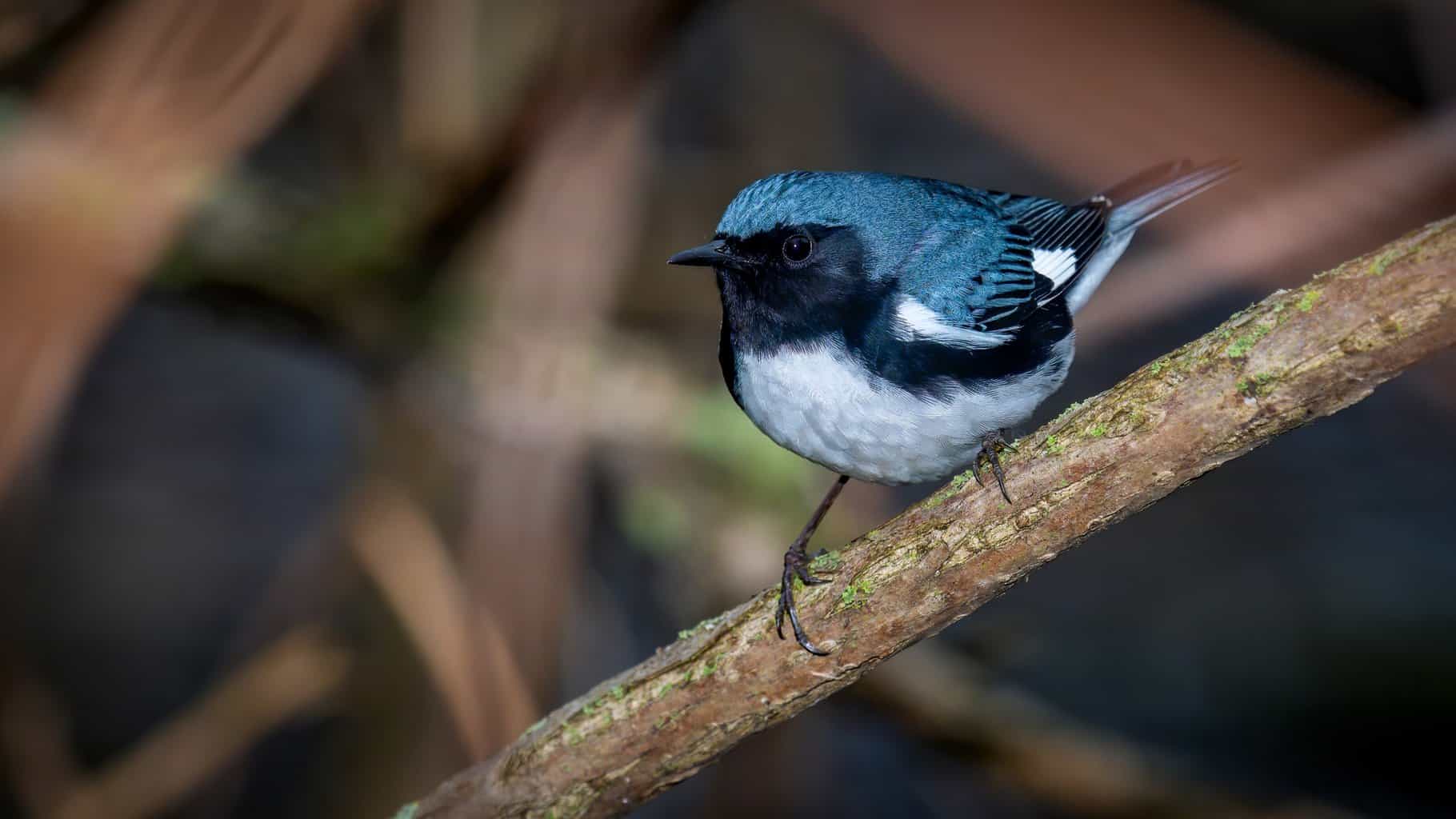
- Scientific Name: Setophaga Caerulescens
- Length: 4.3 – 5 in
- Weight: 0.3 – 0.4 oz
- Wingspan: 7.5 – 8 in
The male Black-throated Blue Warbler is aptly named. It has a black face and throat, a blue back, white underparts, and black and blue wings. On the other side, females have mostly olive plumage with brown wings.
You can find this bird in Maine in summer, hiding in leafy trees seeking canopy in forests. It’s mostly known for its lazy, sluggish behavior. In fact, birders refer to its buzzing call as “I-am-so-la-zee.”
Blue Jay
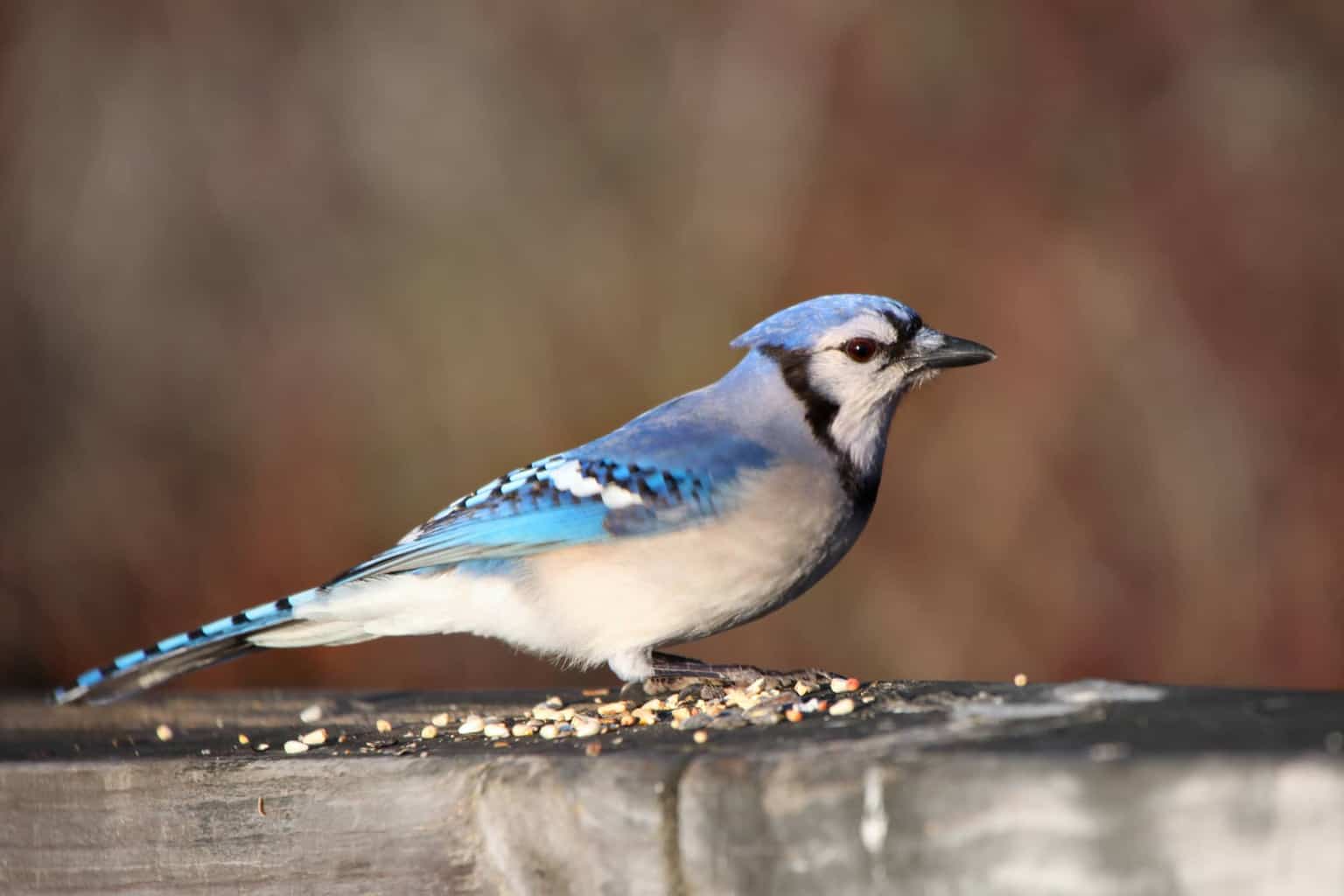
- Scientific Name: Cyanocitta Cristata
- Length: 9.8 – 11.9 in
- Weight: 2.5 – 3.5 oz
- Wingspan: 13.4 – 17 in
The largest of the Jays family, the Blue Jay, is a frequent sighting in Maine. It’s known for being bold, intelligent, and vocal. It loves to inhabit forest edges, yet it won’t think twice about living near human habitats as long as the food is offered up clearly, in a bird feeder, for example.
The Blue Jay will take more seeds than it needs from the feeder, store them in its crop, then fly off and bury them somewhere else as a means of stocking food for the cold days. It might attack other birds in the feeder while doing so. It’s not as friendly as it looks!
It does look amazing, though. Its back and wings show a range of blue hues, while the underparts are mostly white. It has a noticeable blue crest and a black neckline that make it unmistakable to identify.
Green Birds in Maine
Tennessee Warbler

- Scientific Name: Leiothlypis Peregrina
- Length: 4 – 5 in
- Weight: 0.3 oz
- Wingspan: 7.5 – 8 in
Like many birds, the Tennessee Warbler’s name isn’t quite accurate. It doesn’t breed in Tennessee, but it breeds in northern and central Maine, and you have a pretty big chance of spotting it while you’re there.
It’s a small and stocky warbler with yellow-green plumage and a grey cap. It has white underparts, sometimes with a pale yellow wash. Adult males and females look the same. You’ll mostly find them on high branches in forests and woodland seeking canopy.
Orange Birds in Maine
American Robin

- Scientific Name: Turdus Migratorius
- Length: 7.9 – 11 in
- Weight: 2.7 – 3 oz
- Wingspan: 12.2 – 15.8 in
The American Robin inhabits woodlands, farmlands, pine forests, gardens, urban parks, and tundra. You might even find it in your yard looking for favorite foods on the ground, specifically small worms, invertebrates, or small berries. If you find one in your yard, it might be a sign of spring’s arrival.
American Robins have big round bellies that are a rusty orange, while the back parts are brown with subtle black streaks.
Yellow Birds in Maine
Cape May Warbler
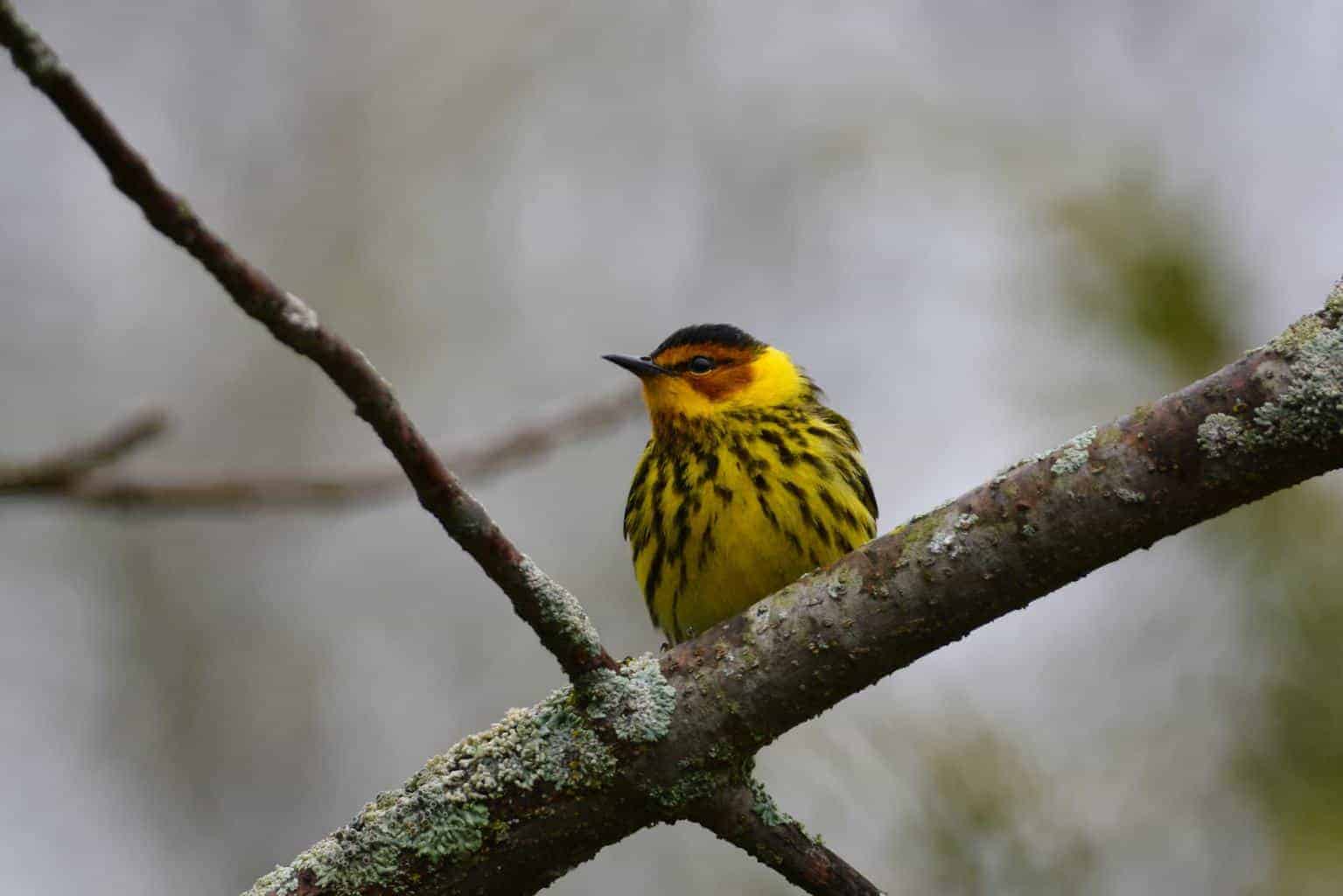
- Scientific Name: Dendroica Tigrina
- Length: 4.7 – 5 in
- Weight: 0.4 – 0.5 oz
- Wingspan: 8 – 8.7 in
If you’re looking for a bird with some bold patterns to see in Maine, you should look for the Cape May Warbler. They have plump bodies with distinct olive and yellow plumage and tiger-like stripes on the chest – explaining its Latin name ‘tigrina’ – and a remarkable chestnut mark on the cheek.
The Cape May Warbler is known for migrating towards the Caribbean in winter. It comes to the Northern part of Maine to breed.
Its most distinct feature is its tubular curled tongue that it uses to feed on nectar, which it relies on during its stay in the Caribbean.
American Goldfinch
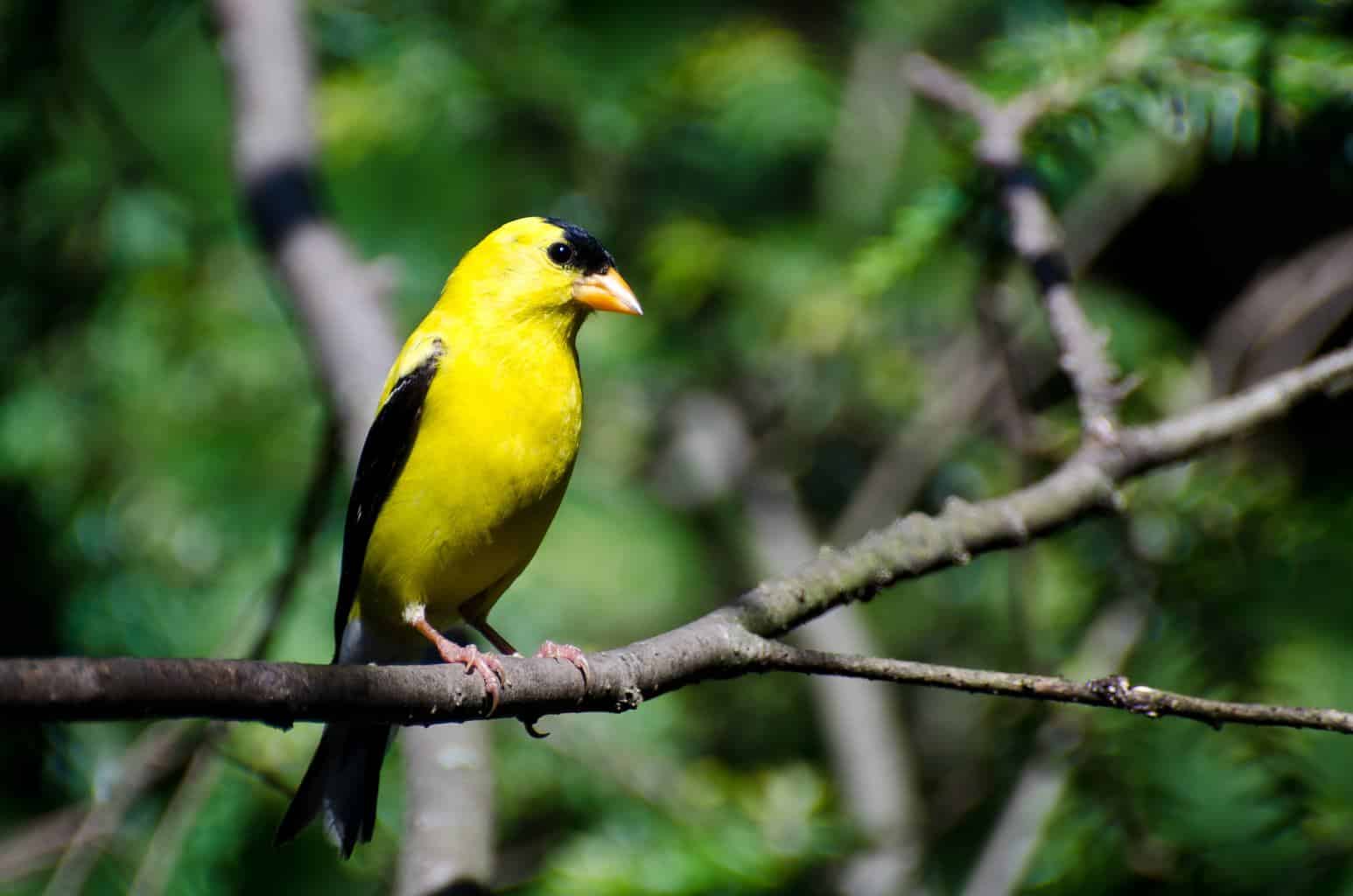
- Scientific Name: Spinus Tristis
- Length: 4.3 – 5 in
- Weight: 0.4 – 0.7 oz
- Wingspan: 7.5 – 8.7 in
Commonly known as the ‘wild canary,’ the American Goldfinch is spread all over the US, and Maine is no exception.
Although you’re probably familiar with the bright yellow male, you might find it’s changed its color to olive as winter approaches. Females are olive all year long. You can identify them from their thick conical bills and black wing bars.
The American Goldfinch is a frequent visitor to bird feeders, and it loves weedy fields, as well. Apart from appearance, you can look for their distinct ‘po-ta-to-chip’ song to identify them.
Other Birds to Watch for in Maine
Surf Scoter
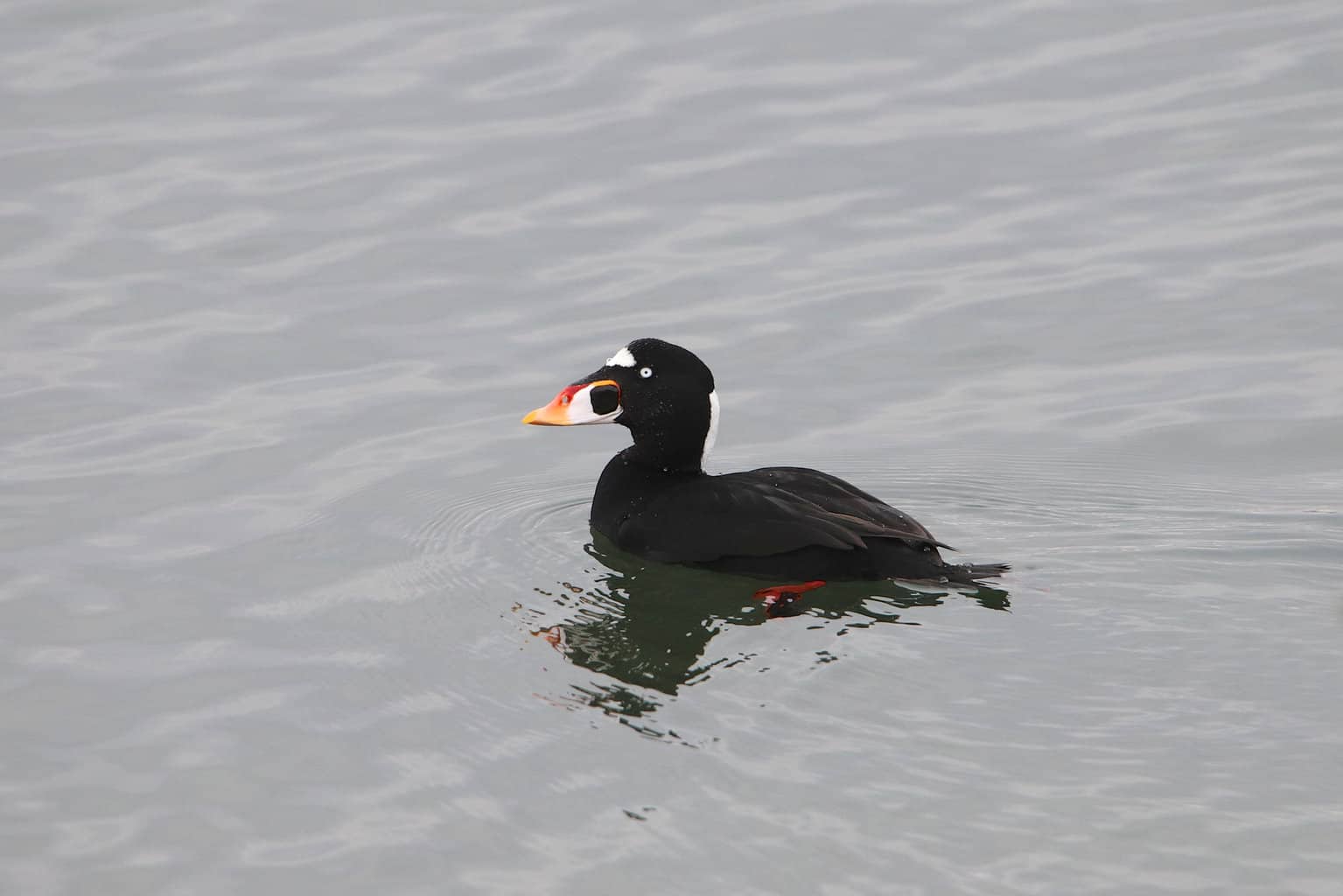
- Scientific Name: Melanitta Perspicillata
- Length: 19 – 23.6 in
- Weight: 31.8 – 45.5 oz
- Wingspan: 30 – 30.3 in
The Surf Scoter is super easy to identify thanks to its large orange-sloping beak with white patches. Males are black, while females are brown, and both have a white patch on their faces.
Usually, they travel in flocks with other scoters. You can find them floating off Maine’s coasts in winter. While they’re floating on the water’s surface, Surf Scoters dive for prey, where they eat small crabs, marine worms, and mussels.
Northern Gannet

- Scientific Name: Morus Bassanus
- Length: 36.5 – 43.3 in
- Weight: 87 – 127.3 oz
- Wingspan: 71 – 72.4 in
The Northern Gannet is the biggest bird you’ll see in Maine, as it’s the biggest seabird in the North Atlantic. Males and females have dense white bodies with black wingtips and dagger-like bills to catch prey.
Northern Gannets fly in slow wingbeats, searching for prey, and when they find it, they plunge into the water to get it. You’d be lucky to catch this scene because they usually do it in flocks that might expand to include thousands of Gannets.
They love to nest on cliffs near oceans, where they forage.
Gyrfalcon

- Scientific Name: Falco Rusticolus
- Length: 19 – 25.2 in
- Weight: 28.2 – 72 oz
- Wingspan: 48.4 in
While in Maine, you might spot the Gyrfalcon, the world’s largest falcon, during winter in open areas or near the coast as a part of its migration.
Gyrfalcons are polymorphic, as they change color according to the weather, so their plumage can range from dappled white to black.
Gyrfalcons have relatively long tails and a pointed wing shape. Females are remarkably larger and heavier than males. They prefer to nest on cliffs and in conifer nests with other eagle species.
Common Eider
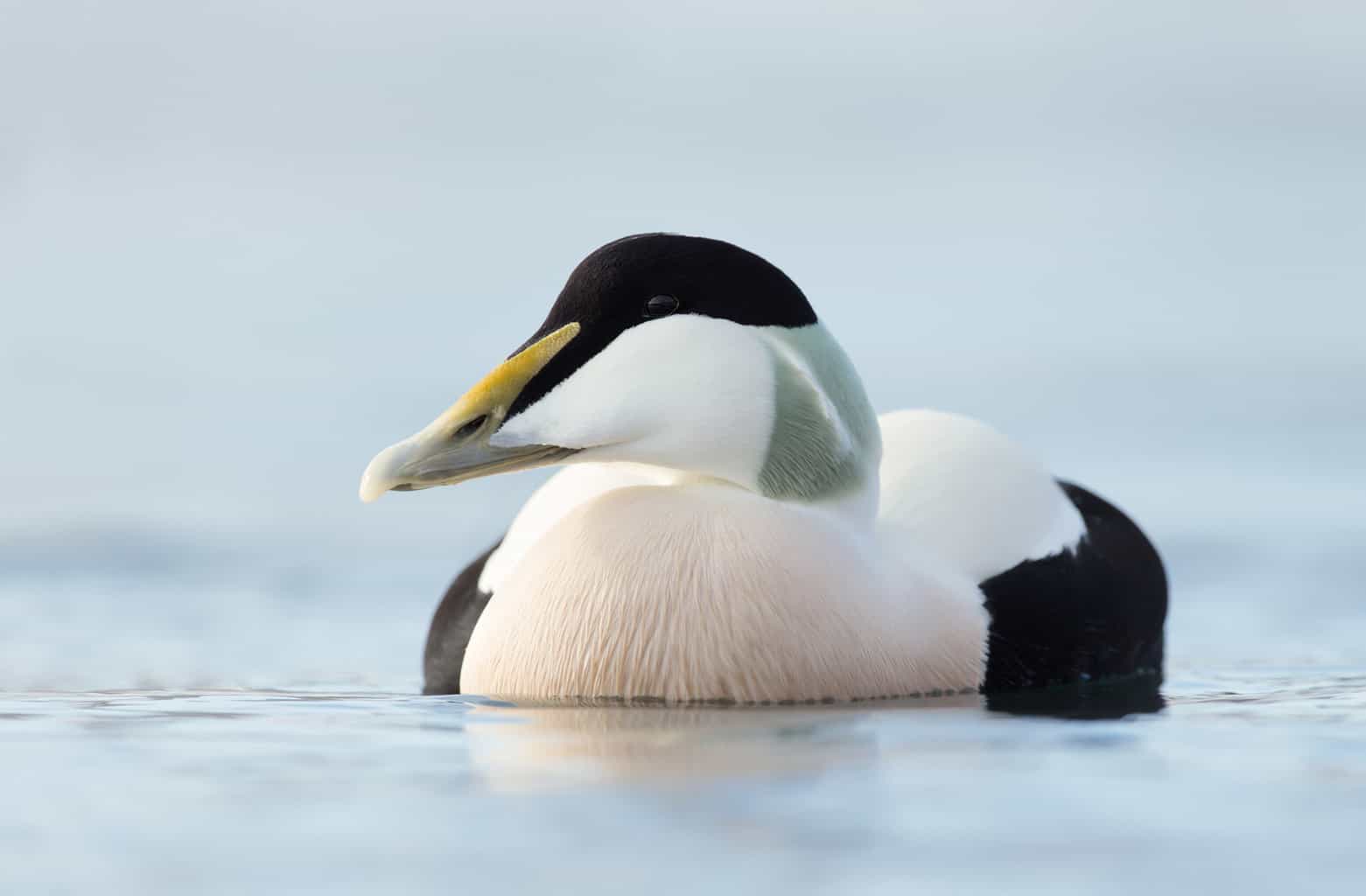
- Scientific Name: Somateria Mollissima
- Length: 19.7 – 28 in
- Weight: 46 – 92.1 oz
- Wingspan: 37.4 – 38.6 in
The Common Eider is a large, stocky, lethargic duck that you’ll find along the eastern coast of Maine. It looks elegant thanks to its sloping forehead, black and white plumage, and smooth motion on the face of the water.
During the breeding season, Common Eiders benefit from non-breeding females ‘aunts,’ as they stay around the nests to protect unhatched eggs. When the eggs hatch, the aunts accompany the ducklings to water with their moms to protect them as well. Isn’t that cute?
King Eider
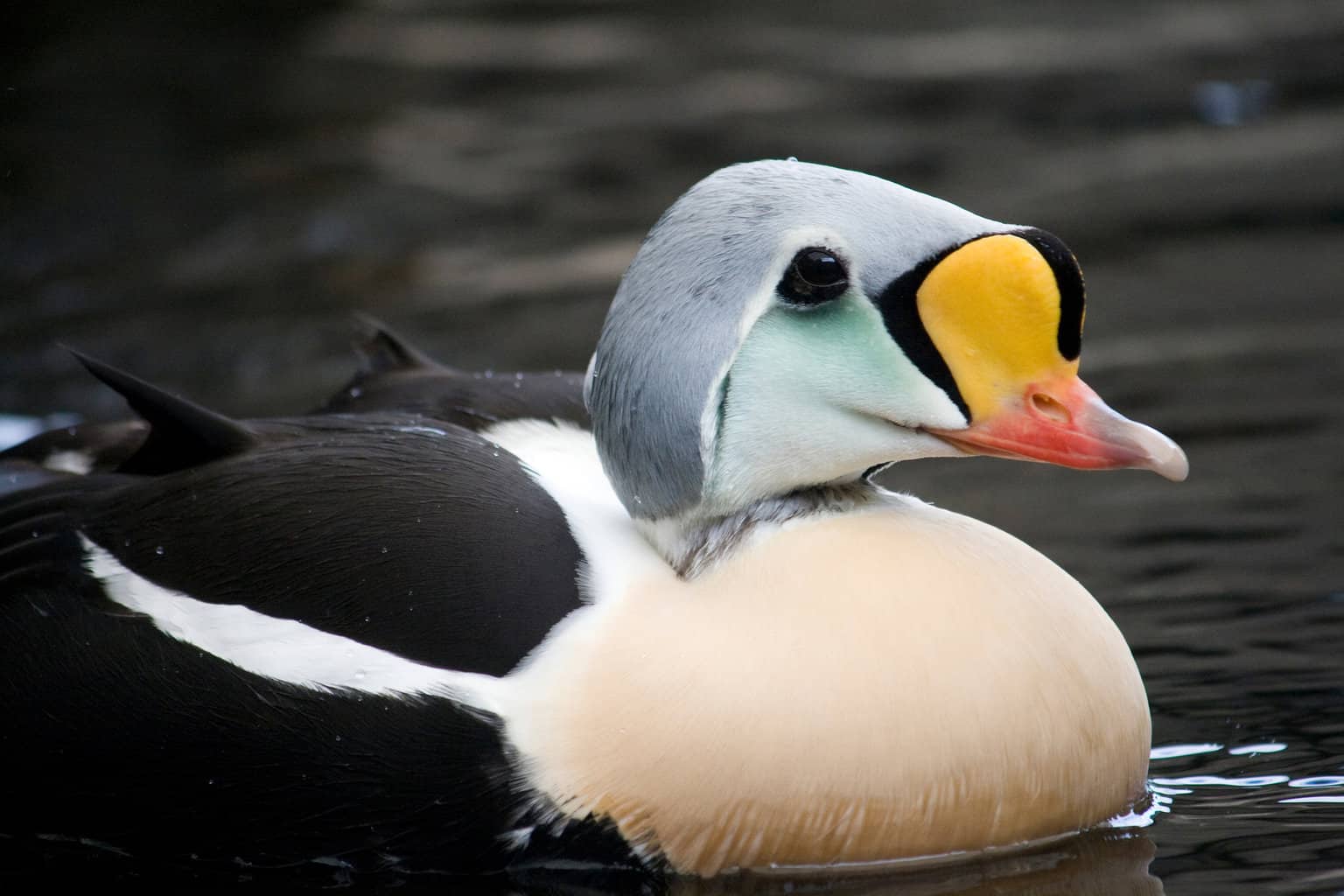
- Scientific Name: Somateria Spectabilis
- Length: 28.5 – 25.1 in
- Weight: 42.3 -74 oz
- Wingspan: 37 in
It’s hard to spot a King Eider in Maine -it has to be during winter- but it’s totally worth it!
The male King Eider is a work of art by itself. Its head and beak have a distinctive appearance; a pearl blue forehead, green cheeks, an orange part behind the beak, and a red beak. All of that is complemented by black and white plumage with a pale beige breast.
Females are mottled brown with dark beaks. While they’re visually less attractive than males, you’ll find the male King Eider pushing its head forward, circling the female in water in an attempt to grab her attention!
Snow Bunting
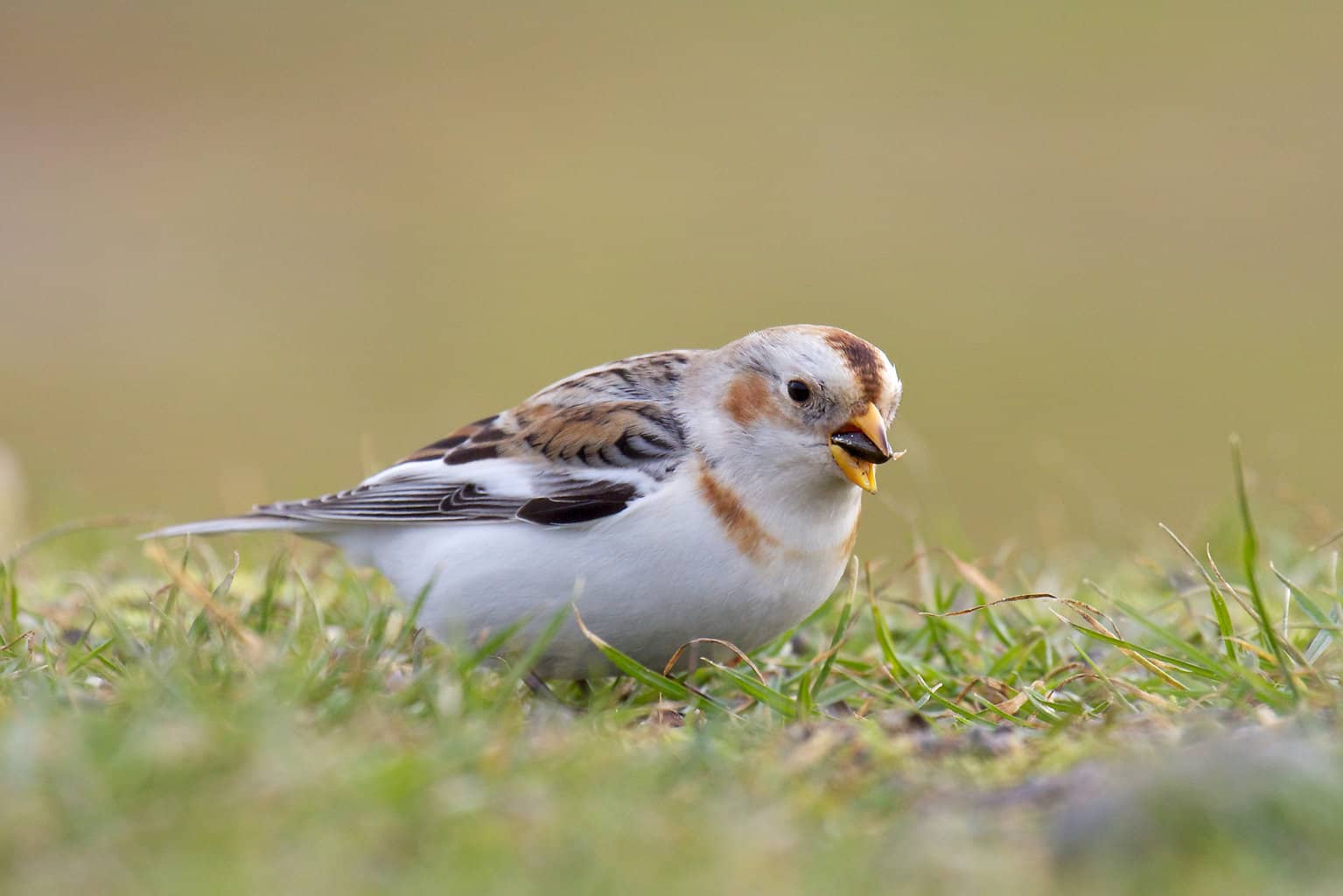
- Scientific Name: Plectrophenax Nivalis
- Length: 5.9 in
- Weight: 1- 1.6 oz
- Wingspan: 11.8 in
Mostly found along shorelines and barren fields in Maine, the Snow Bunting is mostly white with black patches that are distinctive in flight for males, while females have streaky backs and with brown hues all over.
The Snow Bunting flocks to the Arctic to breed, where it walks along barren fields looking for food, blending with the ground that’s covered in snow. Males arrive first to secure nesting spots on rocky tundra.
Iceland Gull
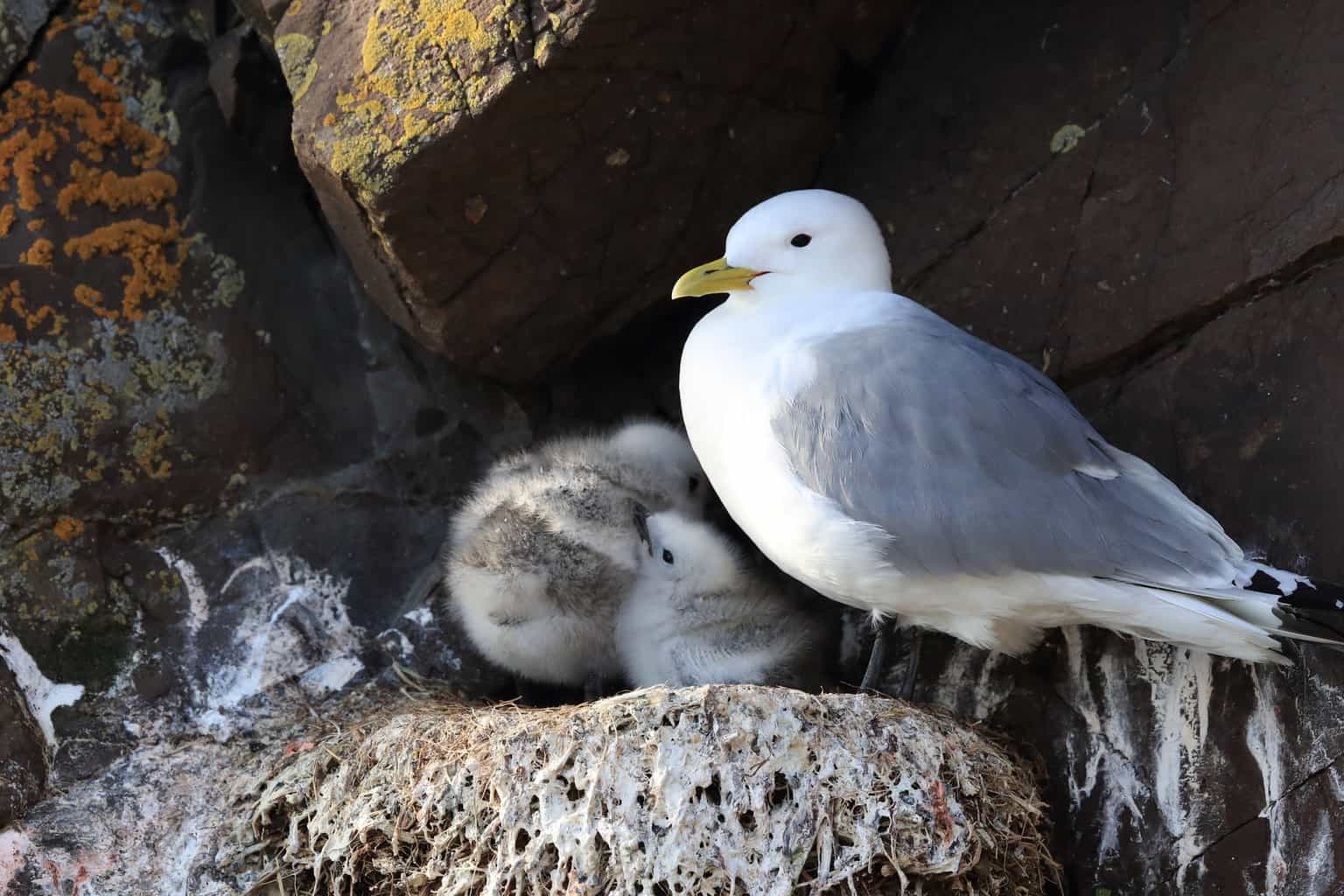
- Scientific Name: Larus Glaucoides
- Length: 19.7 – 23.6 in
- Weight: 29 – 38.8 oz
- Wingspan: 45.3 – 54 in
Iceland Gulls breed in coastal cliffs in the high arctic. They stay along the shore to forage, where they fly low looking for prey, flapping their wings in quick wingbeats. Then, they swoop down to get it.
Usually, they’re seen as parts of mixed flocks with other gulls.
The Iceland Gull looks graceful while in flight; it has pale grey plumage, long wings, slender yellow bills, and pale red legs. The color of its wings varies according to the season between pale grey, pale brown, and dark grey.
Piping Plover

- Scientific Name: Charadrius Melodus
- Length: 6.7 – 6 in
- Weight: 1.5 – 2.2 oz
- Wingspan: 14 – 15.25 in
It’s true that most of the interesting bird species in Maine happen to be there in winter, but one of the most beautiful sights you can see there in summer is the Piping Plover.
It spends the summer on shorelines breeding and foraging, where it probes muddy shores for marine worms.
Piping Plovers are round, stocky, and pale brown. Their bills are orange with black tips and long orange legs. Birders usually distinguish it by its black crown stripe and another black band around its neck.
Atlantic Puffin

- Scientific Name: Fratercula Arctica
- Length: 10.2 – 11.4 in
- Weight: 11 – 19.4 oz
- Wingspan: 20.9 in
The Atlantic Puffin, or what’s rather known to be the ‘Clown of the Sea,’ is a must-see while you’re in Maine. It has black and white plumage and a huge colorful bill.
In fact, Atlantic Puffins were on the edge of extinction, as they were hunted for their feathers and eggs. However, the efforts of a project called the ‘Puffin Project’ in 1973 managed to bring them back to good numbers.
Atlantic Puffins breed in island burrows of the North Atlantic. Other than that, it stays bobbing on water and dives to catch small fish.
American Crow
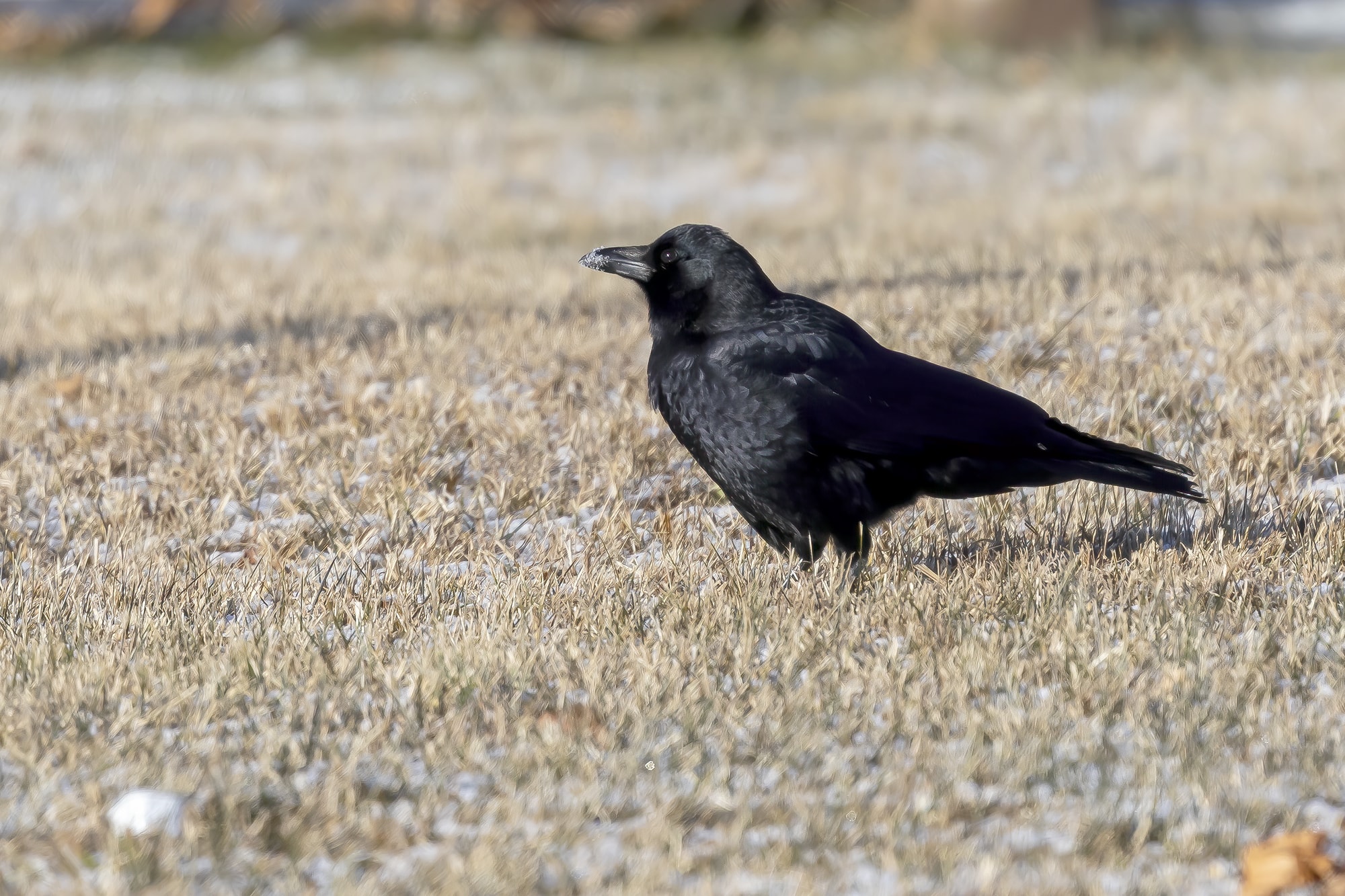
- Scientific Name: Fratercula Arctica
- Length: 15.8 – 21 in
- Weight: 11.2 – 22 oz
- Wingspan: 33.5 – 39.4 in
The all-black American Crow is a year-round resident in Maine. It might show up at your birdfeeder, but you won’t like it, as it feeds on large insects and small mammals.
Apart from their familiar cawing sound, American Crows are known for their glossy black wings. They show clearly in flight, as it moves them in a rowing motion with occasional glides in between.
Razorbill

- Scientific Name: Alca Torda
- Length: 16.9 in
- Weight: 17.8 – 31.5 oz
- Wingspan: 24.8 – 26.8 in
Another seabird with a huge bill that you can spot in Maine is the Razorbill. It nests offshore and along the coast all year round in Maine.
The Razorbill is the size of a crow, with a black back and white underparts. During the breeding season, there’s a thin white line that goes on its face and bill.
Birders look for the massive black bill of the Razorbill to identify it. Despite its being an all-year resident in Maine, the Razorbill is rare to find because of its low number. It’s also understudied.
Snowy Owl
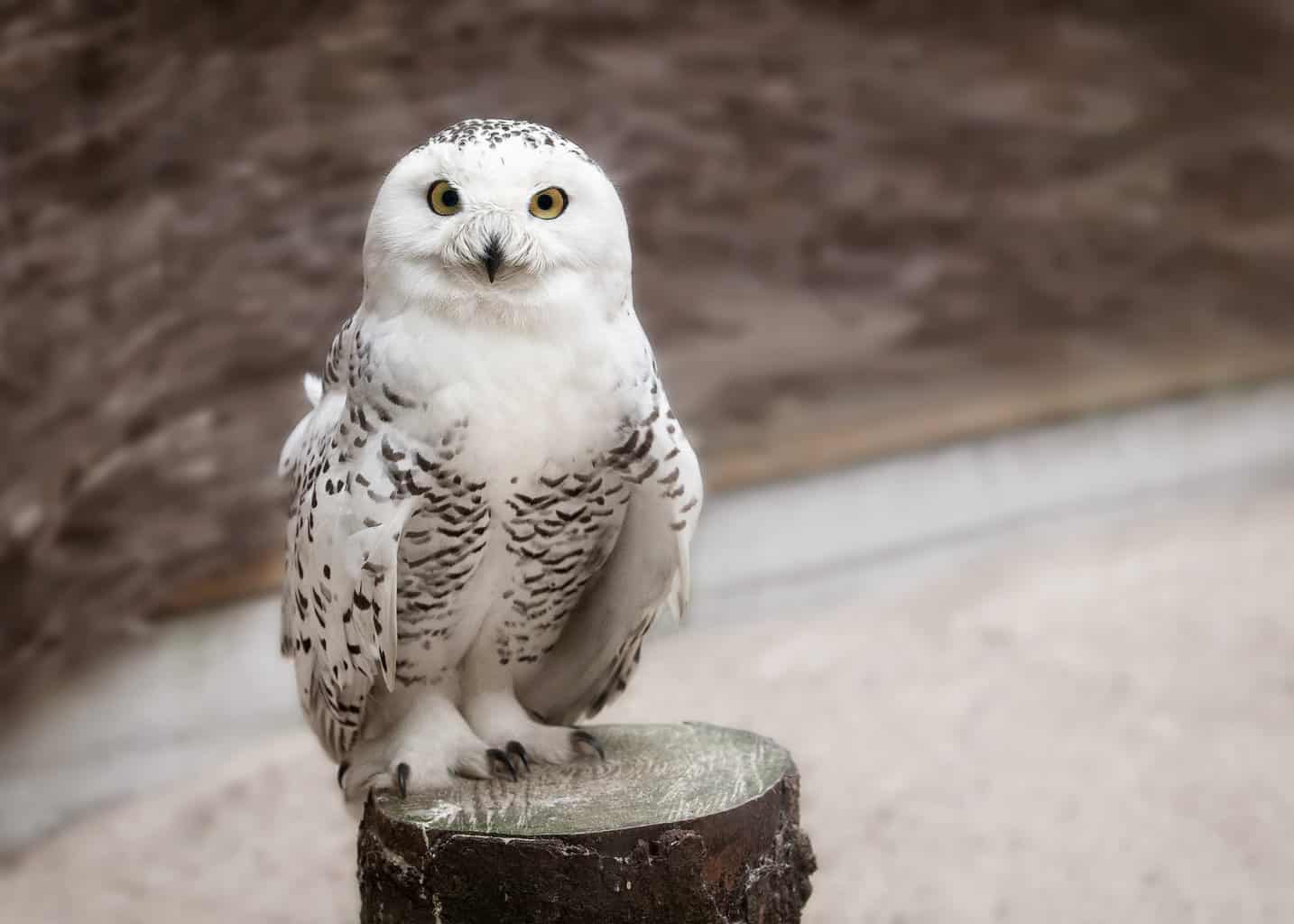
- Scientific Name: Bubo Scandiacus
- Length: 20.5 – 28 in
- Weight: 56.4 – 104 oz
- Wingspan: 49.6 – 57 in
Maine is one of the rare places where you can spot a Snowy owl. A snowy owl looks like a rock covered in snow; it has white plumage mottled with brown.
Look for them perched on small risings in open land, places like fenceposts, dunes, and the like. You might spot them along the shores of lakes and oceans in winter.
The Snowy owl resides in Maine because of its food abundance, where it preys on small ducks and rodents. In winter, staying near the ground on snowy lands is the perfect camouflage for it.
You’d be lucky to spot a snowy owl while in Maine!
Ruffed Grouse
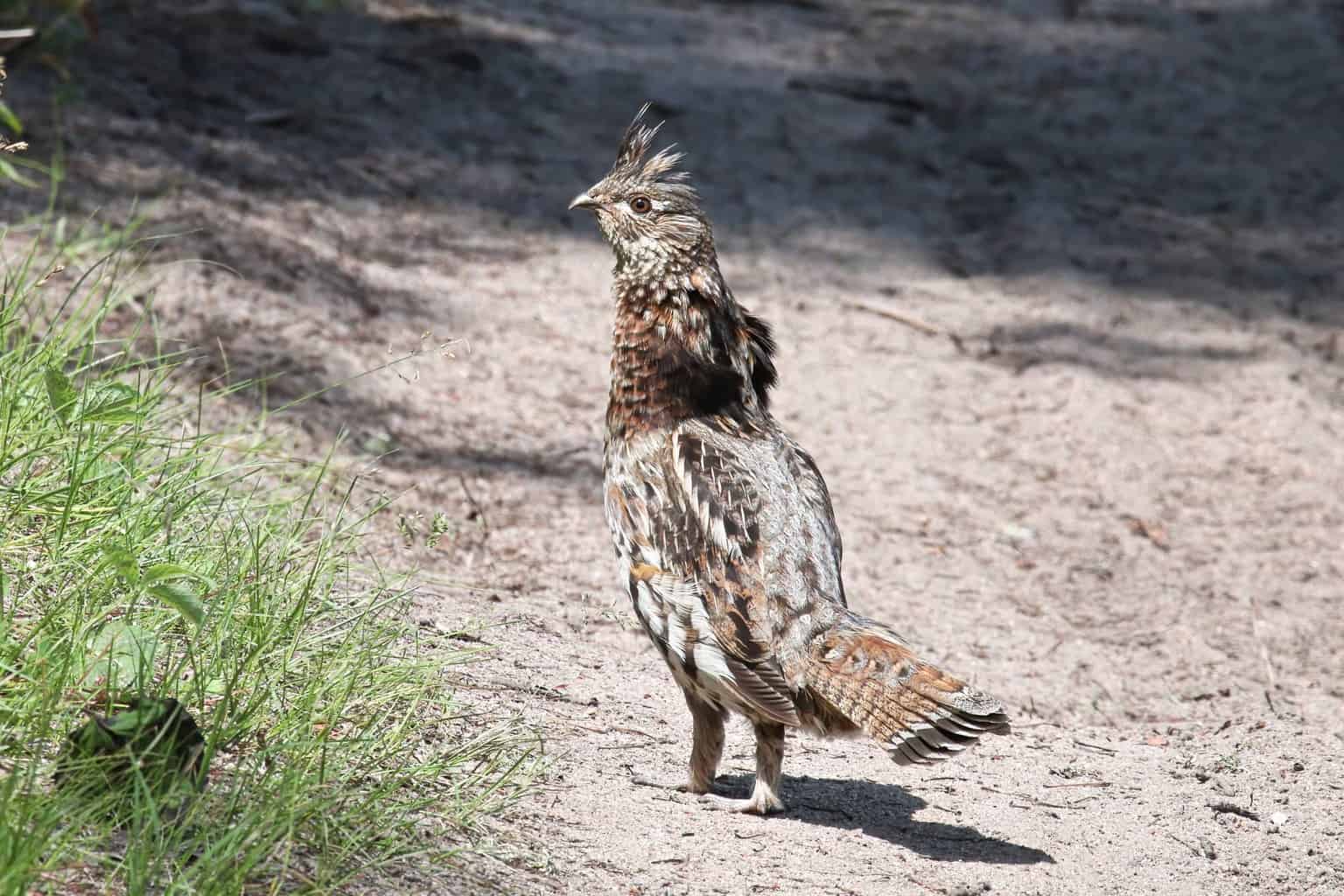
- Scientific Name: Bubo Scandiacus
- Length: 15.8 – 19.7 in
- Weight: 16 – 26.5 oz
- Wingspan: 19.7 – 25.2 in
The Ruffled Grouse is one of the few birds in Maine that you won’t find along the shore but rather in deciduous trees in forests, camouflaging in the woods.
They have short crests, and their plumage is mostly light brown with dark brown barrings and spottings.
They’re most sought after in fall when the male performs its display for females by fluffing the black ruffs around its neck. They also make a drumming sound as a result of flapping their wings.
Barnacle Goose

- Scientific Name: Branta Leucopsis
- Length: 22 – 28 in
- Weight: 43.2 – 78.4 oz
- Wingspan: 51 – 57 in
This beautiful, small, rare goose usually breeds in Iceland and Greenland and comes to the Northern Hemisphere looking for ‘warmer’ weather.
It has a long black neck, white face, and light grey plumage with black and light brown texture. Its underparts are white. Combining these, you get a work of art that you’d be pleased to see.
While their visits to Maine are rare, they’re usually a part of a mixed flock alongside Canada Geese.
Canada Jay
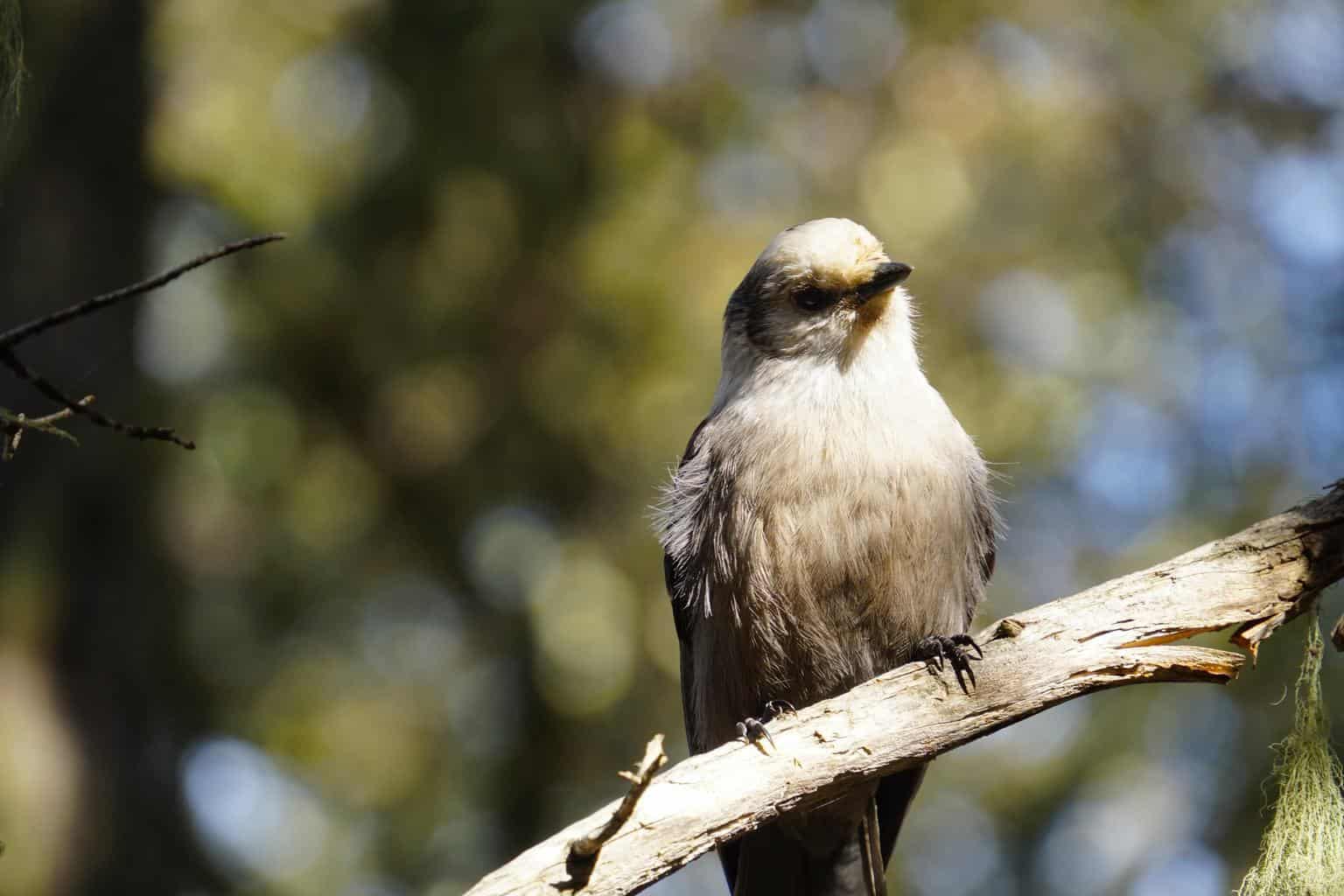
- Scientific Name: Perisoreus Canadensis
- Length: 9.8 – 11.5 in
- Weight: 2 – 3 oz
- Wingspan: 18 in
A lover of coniferous mountain forests, the Canada Jay is another bold, entertaining bird that you might encounter while you’re in Maine.
It’s curious and always on the lookout for food. If you’re hiking in a forest in Maine, you’ll probably find yourself followed by a couple of Canada Jays just out of their curiosity!
The Canada Jay is relatively large for a songbird. Juveniles are dark grey, and their plumage turns into pale grey as they age. They have white parts on the throat, cheeks, and face. It does have a wide range of sounds, but all in all, they’re considered relatively quiet jays.
Great Cormorant

- Scientific Name: Phalacrocorax Carbo
- Length: 33 – 35.4 in
- Weight: 91.7 – 130.5 oz
- Wingspan: 51.2 – 53 in
The Great Cormorant is a large, heavy seabird with a long neck and hooked bill.
It’s known for the white patches on its throat, cheeks, and flanks. Other than that, it’s primarily black except for a yellow part on its face.
Although native to Europe, it resides in offshore nests in Maine all year round. It sits low in the water, then dives in to catch fish. Its wings have minimal waterproofing, so it gets out, stands on a rock, and spreads its wing in sunlight to dry.
Black-Capped Chickadee
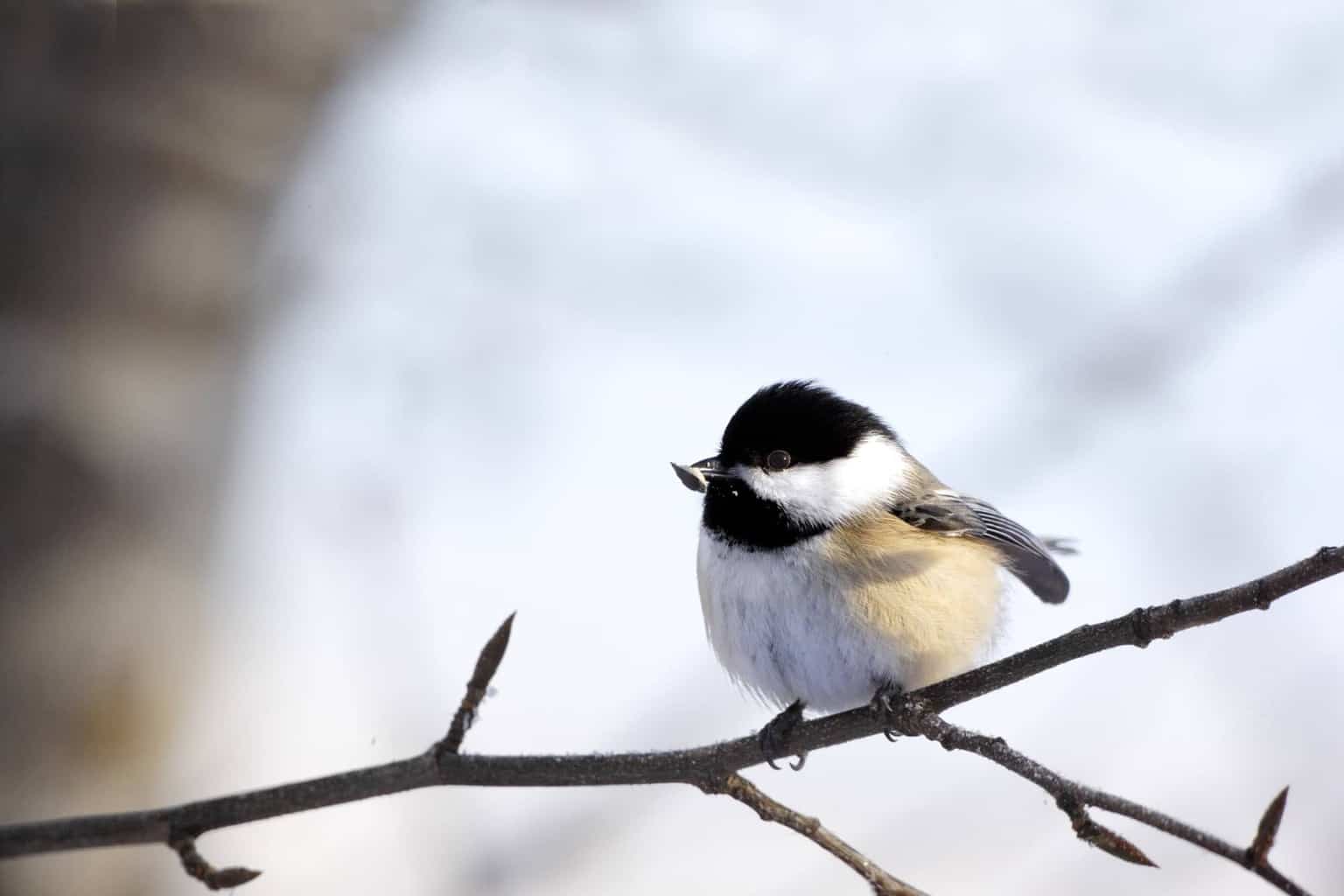
- Scientific Name: Poecile Atricapillus
- Length: 4.7 – 6 in
- Weight: 0.3 – 0.5 oz
- Wingspan: 6.3 – 8.3 in
Who won’t like to spot a cute Chickadee?
Chickadees are among the most beloved birds, thanks to their cute appearance with rounded heads and stocky bodies.
The Black-Capped Chickadee is considered Maine’s state bird. It’s known for its black cap and bib, complemented by white cheeks. Elsewhere, it is pale grey with light buffy underparts.
Black-Capped Chickadees are year-long residents of Maine’s deciduous forests. They’re acrobatic and usually in the air; they rarely stay at a birdfeeder. Instead, they just grab their food and go!
Herring Gull

- Scientific Name: Poecile Atricapillus
- Length: 22.1 – 26 in
- Weight: 28.2 – 44 oz
- Wingspan: 54 – 57.5 in
The Herring Gull is the quintessential American gull that’ll land on your boat or that you might see in your parking lot.
It has the classical gull appearance of white and pale grey plumage with pink legs and an orange bill.
One of the mind-blowing aspects of the Herring Gull is its ability to use bait to catch prey. It might also snatch another bird’s meal, in midair!
It resides along the coasts and near large reservoirs and lakes. They love to look for food in garbage dumps as well.
Wrap Up
Not only is it a state in which to enjoy exotic seafood and rocky shores, but Maine is one of the best states to watch some seabirds that you probably won’t see elsewhere. If you manage to go there in winter or spring, you’re guaranteed some good birding fun!

